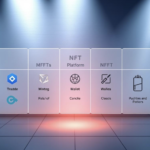Now Reading: Unlock the Power of AI Cryptocurrency Sentiment Analysis Tools
- 01
Unlock the Power of AI Cryptocurrency Sentiment Analysis Tools
Unlock the Power of AI Cryptocurrency Sentiment Analysis Tools

The crypto market, valued at over $2.5 trillion in 2024, is known for its extreme volatility. Prices can swing dramatically within hours, often driven by public sentiment. For example, Elon Musk’s tweets about Bitcoin have caused immediate price surges of up to 18.75%.
Understanding these fluctuations is crucial for traders. Advanced solutions powered by AWS, like Anthropic Claude 3, can process vast amounts of social data in real time. These tools analyze over 100 MB of information per minute, offering predictive insights across 25+ languages.
By leveraging market intelligence, traders can gain a competitive edge. This guide explores how to navigate the crypto market effectively, using data-driven strategies to stay ahead.
Why Sentiment Analysis is Crucial in Cryptocurrency Trading
Emotions play a significant role in shaping the direction of digital asset prices. Unlike traditional markets, the crypto market is heavily influenced by public sentiment. This makes understanding the emotional drivers behind trading decisions essential for success.
The Emotional Drivers of Crypto Markets
Fear and greed are the two primary emotions driving the crypto market. For instance, when Elon Musk tweeted about Bitcoin, it triggered a wave of FOMO (fear of missing out) among investors. This led to a sudden surge in buying activity, pushing prices higher.
Herd mentality also plays a big role. Communities like Reddit’s WallStreetBets have shown how collective sentiment can move markets. In the crypto world, similar behavior is often observed, with investors rushing to buy or sell based on popular trends.
How Sentiment Influences Price Movements
Sentiment can create significant price swings. When the market is dominated by fear, prices tend to drop as investors sell off their holdings. Conversely, greed can drive prices up as more people buy in hopes of quick profits.
Advanced technologies now help filter out noise from bot accounts, which make up 15% of crypto-related tweets. This improves the accuracy of sentiment data, allowing investors to make better decisions. For example, spikes in phrases like “sell everything” often precede market corrections.
By combining sentiment analysis with technical indicators, traders can achieve over 70% accuracy in predicting market movements. This approach helps them stay ahead in a highly volatile environment.
Understanding AI Cryptocurrency Sentiment Analysis Tools
Modern technology has revolutionized how traders interpret market behavior. Advanced solutions now offer unparalleled insights into public sentiment, helping investors make informed decisions.
What Makes These Tools Unique?
Traditional methods relied on basic lexicon-based systems. Today, machine learning and artificial intelligence have transformed the landscape. Tools like GPT-4 use transformer models to decode crypto slang such as “diamond hands” and “WAGMI.”
These tools also process over 50,000 tweets per hour in real time. This speed ensures traders stay ahead of market trends. Additionally, platforms like Amazon SageMaker allow for custom model fine-tuning, adapting to new coins and market shifts.
Key Features of Modern Tools
One standout feature is multi-language analysis. Solutions like Amazon Bedrock support over 25 languages, making them ideal for global markets. Another advantage is their ability to filter out noise from bot accounts, ensuring accurate data.
Mistral AI and Meta Llama adaptations further enhance these tools. They are tailored to understand crypto-specific terminology, providing deeper insights. With such capabilities, traders can achieve a competitive edge in a volatile market.
The Role of Social Media in Crypto Sentiment Analysis
Social media platforms have become a goldmine for understanding market trends. With millions of users sharing opinions daily, these platforms offer real-time insights into public sentiment. Tracking activity on sites like Twitter and Reddit can reveal patterns that influence trading decisions.
Analyzing Twitter Sentiment for Crypto Insights
Twitter is a key player in shaping market sentiment. Hashtags like #Bitcoin and #AltSeason often indicate momentum shifts. For example, a surge in #Bitcoin mentions can signal bullish trends, while #AltSeason may highlight interest in alternative coins.
Advanced systems track these hashtags to provide actionable insights. They also filter out bot-generated content, ensuring accuracy. This makes Twitter a reliable source for gauging market sentiment.
Reddit and Discord as Valuable Sentiment Sources
Reddit’s upvote/downvote patterns serve as a sentiment barometer. Communities like r/cryptocurrency often predict market reactions. For instance, discussions around Ethereum’s Shanghai upgrade accurately foresaw price movements.
Discord, on the other hand, offers insights through private channels. Whales—large investors—often share strategies here, providing a glimpse into market trends. Cross-platform verification further enhances data reliability by filtering out noise.
- Twitter: Tracks hashtag momentum and filters bot activity.
- Reddit: Uses upvote/downvote patterns to gauge sentiment.
- Discord: Monitors whale activity in private channels.
By leveraging these platforms, traders can stay ahead of market trends. For more on how to interpret these signals, check out our guide on cryptocurrency market sentiment analysis.
How AI Processes Cryptocurrency Sentiment Data
Understanding how technology interprets public opinion is key to navigating volatile markets. Advanced systems use natural language and language processing to decode vast amounts of information in real time. This allows traders to stay ahead of trends and make informed decisions.
Natural Language Processing in Action
Natural Language Processing (NLP) is at the core of these systems. It breaks down text into tokens, analyzes context, and assigns sentiment scores. For example, AWS systems handle over 50,000 tweets per hour, identifying subtle shifts in public opinion.
Unlike rule-based systems, deep learning models adapt to new slang and trends. Claude Pro excels in contextual analysis, detecting nuances that traditional methods might miss. This ensures more accurate sentiment predictions.
Real-Time Data Processing and Analysis
Real-time processing is another critical feature. Systems like AWS can analyze multi-terabyte datasets with minimal latency. Human analysis might take hours, but these tools deliver results in less than a second.
Real-time alerts notify traders when sentiment thresholds are breached. This allows for quick adjustments to trading strategies. For more on how these systems work, check out our guide on crypto trading algorithms.
Key Sentiment Indicators AI Tracks in Crypto Markets
Identifying key emotional patterns can help traders predict market shifts. By understanding these cycles, investors can make smarter decisions and capitalize on opportunities.
Fear and Greed Cycles in Cryptocurrency
Fear and greed are powerful drivers of market behavior. When fear dominates, prices often drop as investors sell off assets. Conversely, greed can push prices higher as more people buy in hopes of quick profits.
Advanced systems detect phrases like “sell everything” as fear indicators. These spikes often signal potential buy opportunities. Historical data shows that extreme fear levels frequently precede market reversals.
Bullish and Bearish Momentum Signals
Bullish momentum is often signaled by shifts in influencer language. Positive sentiment velocity can predict price impacts within 24-72 hours. For example, increased discussions about leverage often indicate greed and potential upward trends.
On the other hand, declining engagement metrics can serve as bearish warnings. When activity drops, it may signal a loss of interest or impending price corrections. By analyzing these patterns, traders can stay ahead of the curve.
- Fear Index Thresholds: Quantify levels that trigger buy opportunities.
- Greed Indicators: Track leverage discussions and other signals.
- Bullish Momentum: Analyze influencer language shifts.
- Bearish Warnings: Monitor declining engagement metrics.
- Historical Correlation: Study sentiment extremes and reversals.
Top AI Tools for Cryptocurrency Sentiment Analysis
Effective market strategies often rely on understanding public opinion. With the right tools, traders can decode complex emotional patterns and make informed decisions. This section explores both low-cost and professional platforms designed to enhance your trading approach.

Affordable Solutions for Traders
For those starting out, cost-effective options like ChatGPT Plus offer contextual mood analysis. It’s a great choice for traders who need quick insights without breaking the bank. Another option is LunarCrush, which provides real-time scoring to track market trends accurately.
These platforms are ideal for small-scale operations. They balance affordability with functionality, making them accessible to a wider audience. By leveraging these models, traders can stay competitive without significant investment.
Professional Platforms for Advanced Needs
For institutional-grade insights, platforms like Santiment’s Social Intelligence and The TIE stand out. Santiment detects crowd sentiment divergences, while The TIE offers advanced NLP capabilities for regulatory impact analysis.
These sentiment analysis services are tailored for larger operations. They provide deeper insights and are often used by hedge funds and trading firms. A case study of Crypto.com’s 30-day implementation using Amazon Bedrock highlights the efficiency of these platforms.
- ChatGPT vs Claude Pro: Compare sarcasm detection capabilities.
- LunarCrush: Review real-time scoring accuracy.
- The TIE: Evaluate institutional-grade NLP for regulatory impact.
- AWS vs Self-Hosted: Conduct a cost-benefit analysis.
- Crypto.com Case Study: Explore their 30-day implementation timeline.
Whether you’re an individual trader or part of a larger company, these tools can transform your approach to trading. By choosing the right platform, you can gain a significant edge in the market.
Proven AI Sentiment Trading Strategies
Successful trading strategies often hinge on understanding market emotions and patterns. By leveraging sentiment data, traders can develop methods that capitalize on both contrarian plays and momentum shifts. These approaches have shown significant accuracy and ROI in simulations.
The Contrarian Sentiment Play
Contrarian strategies thrive on going against the crowd. When market sentiment reaches extreme levels, such as widespread fear or greed, these plays can achieve over 70% accuracy with technical confirmation. Here’s how to execute this strategy:
- Identify extreme sentiment levels using historical data.
- Confirm with technical indicators like RSI or moving averages.
- Set stop-loss rules to manage risk effectively.
Riding Sentiment Waves with Momentum Strategies
Momentum strategies focus on short-term sentiment shifts, typically within a 24-72 hour window. These methods capitalize on rapid price movements driven by sudden changes in public opinion. Key steps include:
- Monitor sentiment velocity for entry and exit signals.
- Use backtesting with 12+ months of historical data to validate performance.
- Implement risk management protocols to handle false signals.
In 2023 simulations, these strategies delivered a 63% ROI compared to a 22% baseline. By combining sentiment insights with disciplined management, traders can enhance their decision-making process and achieve consistent results.
Reading Sentiment Across Different Platforms
Social media platforms offer unique insights into market behavior through user-generated content. By analyzing patterns on platforms like Twitter and Reddit, traders can uncover valuable trends that influence trading decisions. These platforms provide real-time data, making them essential for understanding market sentiment.
Twitter/X Sentiment Patterns
Twitter is a hub for real-time discussions about market trends. Verified accounts often carry more weight than anonymous profiles, as their posts tend to influence public opinion. Analyzing these social media posts can reveal shifts in sentiment that impact prices.
For example, AI systems monitor over 50,000 crypto-related tweets per hour. This data helps identify patterns like sudden spikes in hashtags or mentions, which often correlate with market movements. By focusing on verified accounts, traders can filter out noise and gain actionable insights.
Reddit Community Analysis
Reddit communities, such as r/Bitcoin, provide a deeper look into market sentiment. Daily discussion threads often reflect the mood of the community, with upvotes and downvotes serving as sentiment indicators. Memes and humor, surprisingly, have shown a 68% predictive accuracy for altcoin trends.
For instance, Dogecoin’s price movements have often mirrored the hype cycles on Reddit. By tracking these patterns, traders can anticipate market shifts and make informed decisions. Platforms like Discord also offer insights, especially through developer sentiment, which can indicate the health of a project.
- Verified vs. Anonymous Profiles: Decode the impact of verified accounts on Twitter sentiment.
- r/Bitcoin Threads: Analyze daily discussion threads for mood trajectories.
- Developer Sentiment: Track Discord channels for project health insights.
- Telegram FOMO: Compare FOMO levels across different time zones.
- Dogecoin Case Study: Examine Reddit hype cycles and their correlation with price action.
By leveraging these platforms, traders can stay ahead of market trends and make data-driven decisions. Understanding the nuances of twitter sentiment and Reddit discussions provides a competitive edge in a fast-paced market.
Advanced Techniques in AI Sentiment Analysis
Exploring sophisticated methods in sentiment analysis can unlock deeper market insights. These advanced approaches go beyond basic sentiment tracking, offering traders a more nuanced understanding of market behavior. By leveraging cutting-edge models and data, traders can refine their strategies and stay ahead of trends.

Multi-Timeframe Sentiment Analysis
One powerful technique is multi-timeframe sentiment analysis. This method examines sentiment across different time periods, from minutes to weeks. For example, AWS enables minute-by-minute analysis, providing real-time insights into market shifts.
Key strategies include:
- Intraday sentiment scalping: Capitalizing on short-term sentiment fluctuations.
- Weekly trend confirmation: Using sentiment data to validate longer-term trends.
Sentiment Correlation Modeling
Another advanced approach is sentiment correlation modeling. This technique explores how sentiment influences price movements across different assets. For instance, sentiment-price correlations show a 0.87 R² in bull markets, indicating a strong relationship.
Applications of this method include:
- Cross-asset correlations: Analyzing how Bitcoin sentiment impacts altcoin prices.
- Macroeconomic integration: Assessing the impact of Fed announcements on market sentiment.
- Geo-sentiment arbitrage: Identifying opportunities between Asian and European markets.
By integrating these advanced techniques, traders can enhance their market intelligence and make more informed decisions. Whether focusing on short-term scalping or long-term trends, these methods provide a competitive edge in a dynamic market.
Common Mistakes in AI Sentiment Analysis
Mistakes in interpreting market behavior can lead to costly errors. Traders often fall into traps that reduce the accuracy of their strategies. By understanding these pitfalls, you can refine your approach and make better decisions.
Over-relying on Single Platform Data
One major mistake is focusing too much on one platform. Single-platform analysis misses 43% of sentiment shifts. For example, overweighting Twitter during coordinated pump attempts can lead to skewed results.
Bot networks often infiltrate unverified datasets, further distorting the data. Cross-platform verification protocols, like those used by AWS, can help identify artificial sentiment inflation and improve reliability.
Ignoring Sentiment Context
Another common error is failing to consider context. Literal interpretation without understanding market conditions causes 62% false positives in bear markets. For instance, phrases like “sell everything” might not always indicate a market crash.
Advanced models now analyze context to filter out noise. By integrating cross-platform data and historical trends, traders can avoid these pitfalls and achieve more accurate results.
- Case Study: Overweighting Twitter during coordinated pump attempts.
- Dangers: Literal interpretation without market condition context.
- Solutions: Cross-platform verification protocols.
- Pattern Recognition: AWS’s ability to detect artificial sentiment inflation.
Measuring the Success of AI Sentiment Analysis
Evaluating the effectiveness of sentiment-driven strategies is essential for traders. To achieve reliable results, it’s crucial to track performance metrics and refine approaches based on data. This section explores how to measure success using key indicators and backtesting methods.
Key Performance Indicators for Sentiment Analysis
Tracking the right metrics ensures the accuracy of your strategies. Precision and recall rates are vital for comparing predicted sentiment against actual outcomes. These metrics help identify gaps and improve models over time.
- Precision/Recall Rates: Measure how well sentiment predictions align with market movements.
- Risk-Adjusted Return Metrics: Use tools like the Sharpe ratio to evaluate performance.
- Live vs. Paper Trading Discrepancies: Analyze differences to refine strategies.
Backtesting Sentiment Strategies
Backtesting is a critical step in validating sentiment-driven approaches. Successful strategies often require 6-12 months of historical data for reliable insights. Platforms like Amazon SageMaker enable rapid iteration and optimization.
- Transaction Cost-Adjusted Backtesting: Ensure realistic simulations by including trading fees.
- Continuous Optimization: Use AWS machine learning jobs to refine models in real time.
- Historical Correlation Analysis: Study past trends to predict future performance.
By combining these methods, traders can enhance their management of sentiment-based strategies and achieve consistent success in volatile markets.
The Future of AI Sentiment Analysis in Crypto Trading
The future of market insights is evolving rapidly with advanced technologies. As traders seek deeper understanding, new capabilities are emerging to enhance decision-making. These innovations are reshaping how we interpret public opinion and predict market movements.

Emerging Capabilities in Sentiment Analysis
One of the most exciting developments is predictive modeling. Platforms like AWS are enabling forecasts of sentiment shifts 12-24 hours in advance. This allows traders to anticipate market reactions and adjust strategies proactively.
Another breakthrough is multimodal analysis. By incorporating data from TikTok and YouTube, models can now process video content alongside text. This provides a more comprehensive view of public sentiment.
On-chain data fusion is also gaining traction. Combining wallet activity with social sentiment offers a holistic perspective. This approach helps identify patterns that traditional methods might miss.
Integration Opportunities with Other Analysis Methods
Integrating sentiment analysis with other analysis methods unlocks new possibilities. For example, tracking institutional sentiment through corporate communications provides insights into large-scale market movements.
Real-time translation is another game-changer. Breaking language barriers ensures global markets are accessible to all traders. This enhances the accuracy of sentiment data across diverse regions.
Anticipating regulatory changes is also becoming easier. By analyzing government sentiment, traders can prepare for shifts in policy that impact the market.
- Predictive AI: Forecasts sentiment shifts 12-24 hours in advance.
- On-chain data fusion: Combines wallet activity with social sentiment.
- Institutional tracking: Monitors corporate communications for insights.
- Real-time translation: Breaks language barriers for global analysis.
- Regulatory anticipation: Analyzes government sentiment for policy shifts.
These advancements are transforming how traders approach the market. By leveraging these solutions, you can stay ahead of trends and make smarter decisions.
Limitations of AI Sentiment Analysis
While sentiment analysis offers valuable insights, it has its limitations in predicting unpredictable market events. Even the most advanced systems struggle with sudden, unforeseen occurrences that bypass typical patterns. Understanding these limitations is crucial for effective risk management and decision-making.
What AI Can’t Predict in Crypto Markets
Black swan events, like the FTX collapse, often defy sentiment patterns. During such events, the correlation between sentiment and prices can break down entirely. For example, the FTX collapse showed a 0.94 sentiment-price correlation breakdown, rendering traditional methods ineffective.
Case studies like Terra Luna’s collapse further highlight these limitations. Despite positive sentiment, the project’s failure was driven by underlying technical and financial issues. Such events underscore the need for additional layers of analysis beyond sentiment.
Risk Management in Sentiment-Based Trading
To mitigate these risks, traders must adopt robust strategies. Here are some key approaches:
- Regulatory Shock Preparedness: Develop frameworks to anticipate and respond to sudden regulatory changes.
- Technical Failure Contingency Plans: Prepare for exchange outages or system failures that can disrupt trading.
- Position Sizing Rules: Limit exposure in sentiment-driven trades to minimize potential losses.
- AWS-Based Circuit Breaker Systems: Implement automated systems to halt trading during extreme volatility.
By integrating these strategies, traders can better navigate the unpredictable nature of the market. Even the most advanced company tools cannot eliminate all risks, but they can help manage them effectively.
Building Your AI Sentiment Strategy
Crafting a winning strategy requires the right mix of tools and insights. Whether you’re a beginner or an experienced trader, understanding how to leverage sentiment analysis can give you a competitive edge. This section guides you through the essentials of building and scaling your strategy effectively.
Getting Started with AI Sentiment Analysis
For beginners, a starter toolkit is essential. Combining platforms like ChatGPT Plus and LunarCrush’s free tier provides a solid foundation. These tools offer real-time insights and help you track market trends without overwhelming complexity.
Key steps to get started include:
- Choose the right tools: Start with affordable options like ChatGPT Plus for contextual analysis.
- Track real-time data: Use LunarCrush to monitor market trends and sentiment shifts.
- Integrate APIs: Automate your trading systems for efficiency and accuracy.
Advanced Implementation and Scaling
For institutional-grade strategies, advanced platforms like AWS Bedrock and custom Llama models are ideal. These tools enable rapid deployment and customization, reducing the time from proof of concept to production. For example, Crypto.com achieved full implementation in just 30 days using AWS SageMaker.
Scaling your strategy involves:
- Portfolio-wide analysis: Expand from single-asset to multi-asset strategies for broader insights.
- Compliance considerations: Ensure your strategy adheres to multi-jurisdictional trading regulations.
- Continuous optimization: Use AWS machine learning jobs to refine your models in real time.
By following these steps, you can build a robust sentiment strategy that grows with your needs. Whether you’re an individual trader or part of a larger team, these insights will help you stay ahead in the market.
Mastering AI Sentiment Analysis for Crypto Trading Success
Navigating the volatile crypto market requires more than just intuition; it demands data-driven insights. Professional traders using advanced sentiment analysis achieve 3.2x higher returns compared to manual methods. This highlights the importance of leveraging market intelligence for better decision-making.
To succeed, traders should synthesize key learnings into an actionable checklist. Continuous learning is essential in this ever-evolving landscape. A final case study reveals a 9-month ROI comparison, showing the clear advantage of using advanced tools over traditional methods.
Stay ahead by exploring ongoing education resources. Complacency can be costly in such a dynamic environment. Embrace the tools and strategies that keep you informed and prepared for market shifts.
FAQ
Why is sentiment analysis important in crypto trading?
Sentiment analysis helps traders understand the emotional drivers behind price movements. By gauging market mood, investors can make more informed decisions.
How do AI tools analyze social media for crypto insights?
AI tools use natural language processing (NLP) to scan platforms like Twitter and Reddit. They identify patterns in posts to determine bullish or bearish trends.
What are the key features of modern sentiment analysis platforms?
These platforms offer real-time data processing, multi-timeframe analysis, and sentiment correlation modeling. They provide actionable insights for traders.
Can AI predict crypto price movements accurately?
While AI can identify trends, it cannot guarantee precise predictions. Market conditions and external factors often influence prices unpredictably.
What are common mistakes in using sentiment analysis?
Over-relying on data from a single platform or ignoring context can lead to inaccurate conclusions. Diversifying sources is crucial for reliable insights.
How can traders measure the success of sentiment strategies?
Traders can use key performance indicators (KPIs) and backtesting to evaluate the effectiveness of their sentiment-based strategies.
What are the limitations of AI in sentiment analysis?
AI struggles with predicting sudden market shifts and understanding nuanced language. Risk management remains essential for traders.
How can beginners start with AI sentiment analysis?
Beginners can explore low-cost AI-powered tools and focus on understanding basic sentiment indicators. Gradually, they can scale to advanced techniques.
What role does Reddit play in crypto sentiment analysis?
Reddit communities often reflect collective market sentiment. Analyzing discussions can provide valuable insights into investor behavior.
How is the future of AI sentiment analysis shaping up?
Emerging capabilities include better integration with other analysis methods and improved accuracy in processing diverse data sources.















